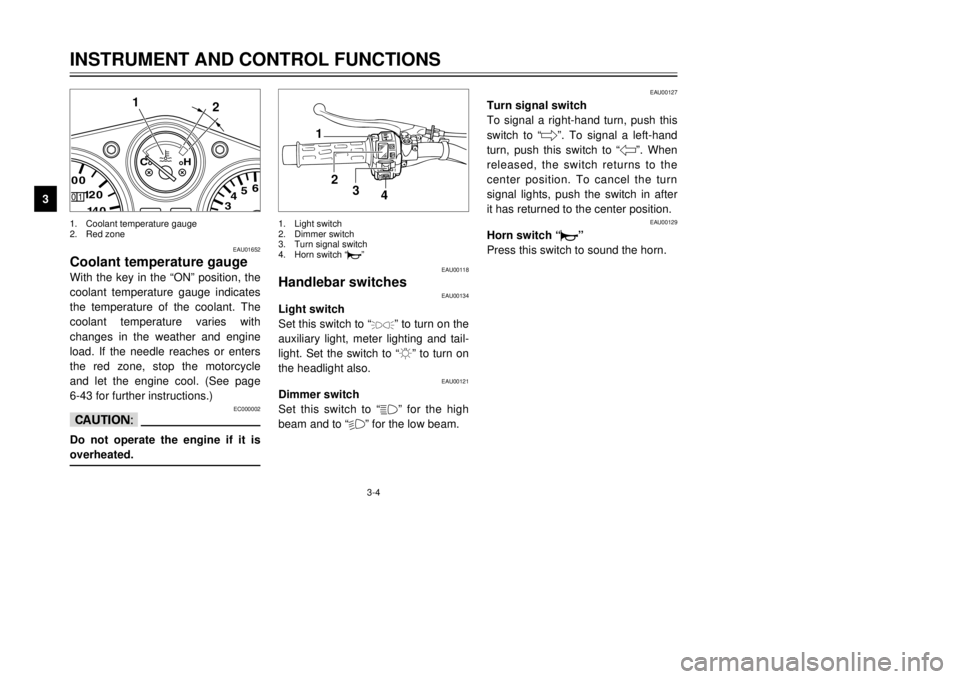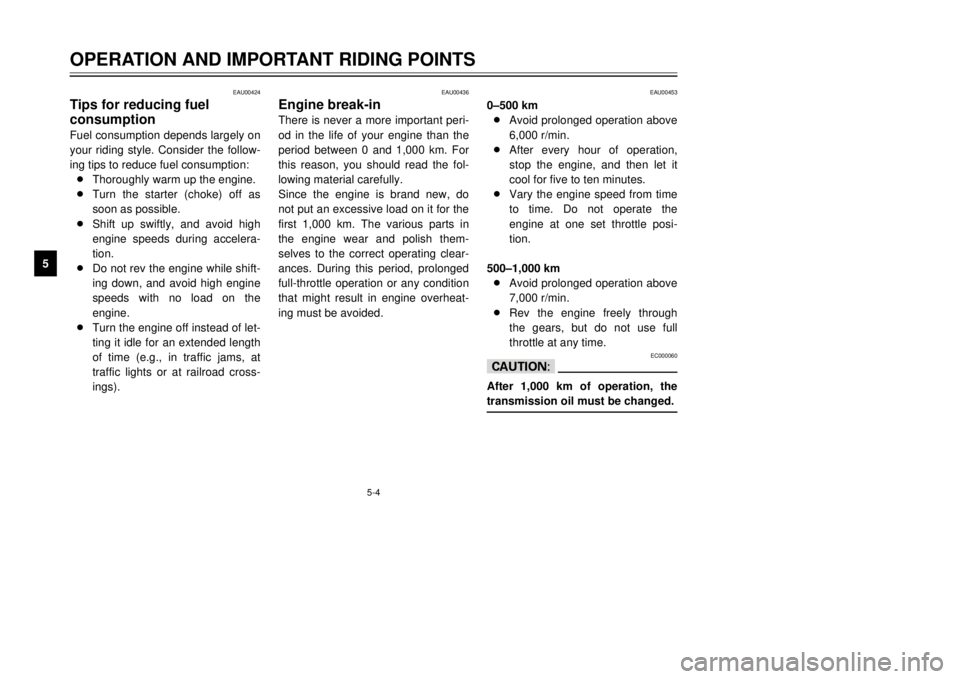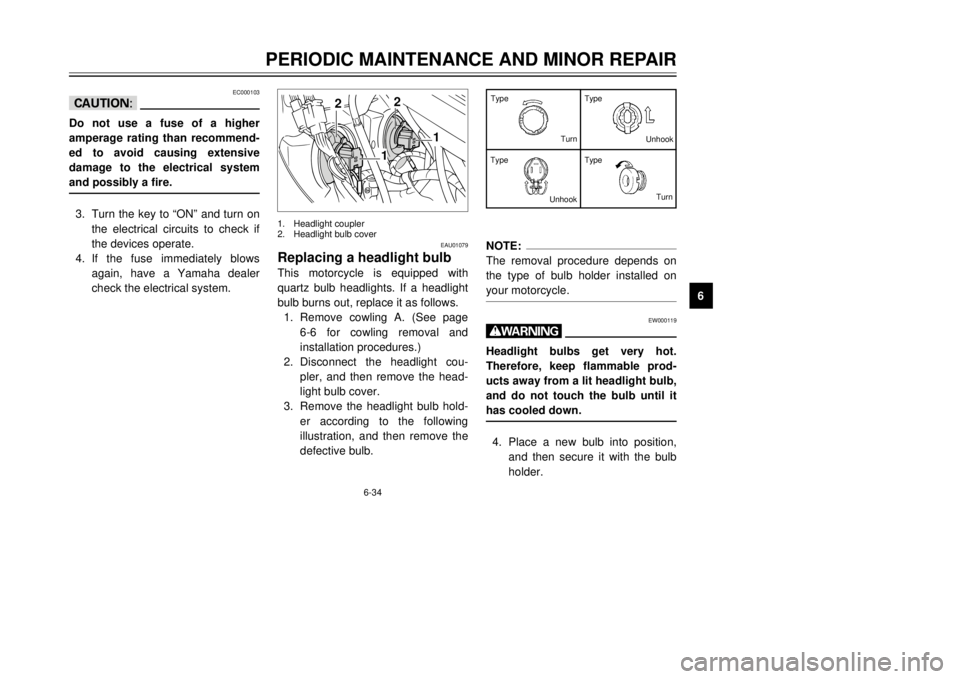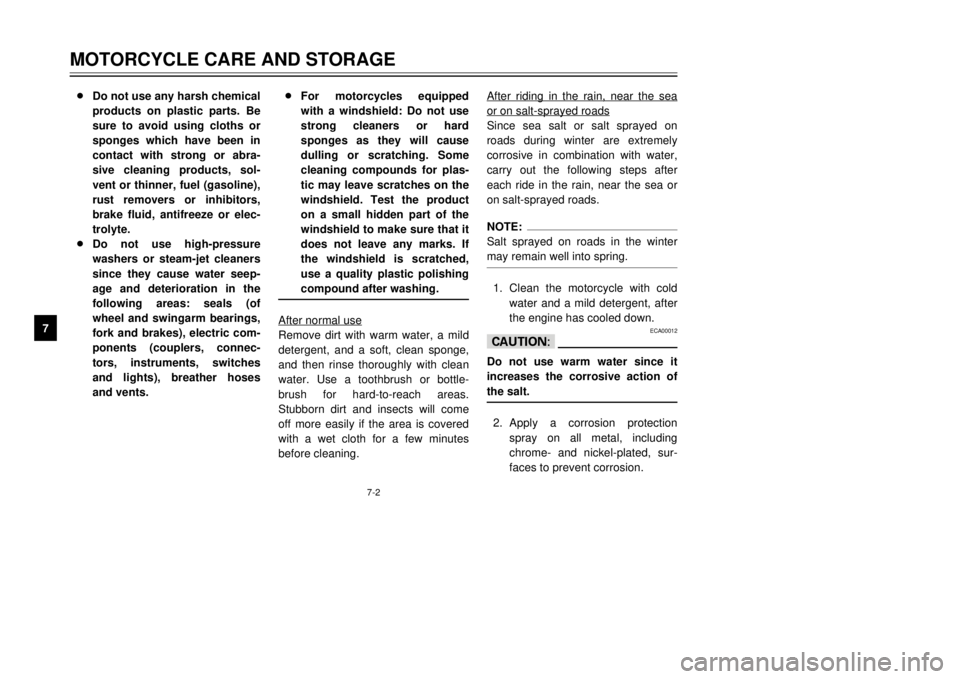2001 YAMAHA TDR 125 lights
[x] Cancel search: lightsPage 6 of 94

EAU00009
TABLE OF CONTENTS
GIVE SAFETY THE RIGHT OF WAY.................1-1
DESCRIPTION....................................................2-1
Left view...........................................................2-1
Right view.........................................................2-2
Controls and instruments..................................2-3
INSTRUMENT AND CONTROL FUNCTIONS....3-1
Main switch/steering lock..................................3-1
Indicator and warning lights..............................3-2
Speedometer unit.............................................3-3
Tachometer......................................................3-3
Coolant temperature gauge..............................3-4
Handlebar switches..........................................3-4
Clutch lever.......................................................3-6
Shift pedal.........................................................3-6
Brake lever.......................................................3-7
Brake pedal......................................................3-7
Fuel tank cap....................................................3-7
Fuel (except for Switzerland and Austria).........3-8
Fuel (for Switzerland and Austria)....................3-8
Catalytic converter
(for Switzerland and Austria)..........................3-9
2-stroke engine oil..........................................3-10
Fuel cock........................................................3-11
Starter (choke) lever ......................................3-12
Seat................................................................3-12Helmet holder.................................................3-13
Adjusting the shock absorber assembly.........3-13
YEIS handling precautions.............................3-14
YPVS..............................................................3-14
Sidestand........................................................3-15
Ignition circuit cut-off system..........................3-16
PRE-OPERATION CHECKS...............................4-1
Pre-operation check list....................................4-1
OPERATION AND IMPORTANT RIDING
POINTS...............................................................5-1
Starting a cold engine.......................................5-1
Starting a warm engine.....................................5-2
Shifting..............................................................5-3
Recommended shift points
(for Switzerland only)......................................5-3
Tips for reducing fuel consumption...................5-4
Engine break-in................................................5-4
Parking.............................................................5-5
PERIODIC MAINTENANCE AND MINOR
REPAIR...............................................................6-1
OwnerÕs tool kit.................................................6-1
Periodic maintenance and lubrication chart......6-2
Removing and installing cowlings and panel....6-5
Checking the spark plug...................................6-7
123
456
5AE-9-E4 (ENG) 8/30/00 5:04 PM Page 5
Page 13 of 94

0
001
0001
00
140
180 120 100 80
1 23456
7
8
9
10
11
12
X1000r/min
km/h
CH
1
2
4
3
EAU03034
Indicator and warning lights
EAU03201
Oil level warning light Ò
7
Ó
This warning light comes on when
the engine oil level is low.
The electrical circuit of the warning
light can be checked according to the
following procedure.
1.Set the engine stop switch to Ò#Ó
and turn the key to ÒONÓ.
2.Shift the transmission into the
neutral position or pull the clutch
lever.3.Push the start switch. If the
warning light does not come on
while pushing the start switch,
have a Yamaha dealer check the
electrical circuit.
NOTE:
Even if the oil level is sufficient, the
warning light may flicker when riding
on a slope or during sudden acceler-
ation or deceleration, but this is not a
malfunction.
EAU00057
Turn signal indicator light Ò5Ó
This indicator light flashes when the
turn signal switch is pushed to the left
or right.
EAU00061
Neutral indicator light ÒNÓ
This indicator light comes on when
the transmission is in the neutral
position.
EAU00063
High beam indicator light Ò&Ó
This indicator light comes on when
the high beam of the headlight is
switched on.
1.Turn signal indicator light Ò5Ó
2.High beam indicator light Ò&Ó
3.Oil level warning light Ò
7
Ó
4.Neutral indicator light ÒNÓ
3-2
INSTRUMENT AND CONTROL FUNCTIONS
1
23
4
5
6
7
8
95AE-9-E4 (ENG) 8/30/00 5:04 PM Page 12
Page 15 of 94

3-4
01140120
10
0
3456
CH1
2
1.Coolant temperature gauge
2.Red zone
EAU01652
Coolant temperature gaugeWith the key in the ÒONÓ position, the
coolant temperature gauge indicates
the temperature of the coolant. The
coolant temperature varies with
changes in the weather and engine
load. If the needle reaches or enters
the red zone, stop the motorcycle
and let the engine cool. (See page
6-43 for further instructions.)
EC000002
cCDo not operate the engine if it is
overheated.INSTRUMENT AND CONTROL FUNCTIONS
1
23
4
5
6
7
8
9
1
2
3
4
EAU00118
Handlebar switches
EAU00134
Light switch
Set this switch to Ò
'
Ó to turn on the
auxiliary light, meter lighting and tail-
light. Set the switch to Ò:Ó to turn on
the headlight also.
EAU00121
Dimmer switch
Set this switch to Ò&Ó for the high
beam and to Ò%Ó for the low beam.
EAU00127
Turn signal switch
To signal a right-hand turn, push this
switch to Ò6Ó. To signal a left-hand
turn, push this switch to Ò4Ó. When
released, the switch returns to the
center position. To cancel the turn
signal lights, push the switch in after
it has returned to the center position.
EAU00129
Horn switch Ò*Ó
Press this switch to sound the horn.
1.Light switch
2.Dimmer switch
3.Turn signal switch
4.Horn switch Ò*Ó
5AE-9-E4 (ENG) 8/30/00 5:04 PM Page 14
Page 31 of 94

4-3
NOTE:
Pre-operation checks should be made each time the motorcycle is used. Such an inspection can be accomplished in a
very short time; and the added safety it assures is more than worth the time involved.
EWA00033
wIf any item in the Pre-operation check list is not working properly, have it inspected and repaired before operat-
ing the motorcycle.PRE-OPERATION CHECKS
1
2
34
5
6
7
8
9
Chassis fasteners¥Make sure that all nuts, bolts and screws are properly tightened.
¥Tighten if necessary.Ñ
Instruments, lights,
signals and switches¥Check operation.
¥Correct if necessary.3-2Ð3-6
Sidestand switch¥Check operation of ignition circuit cut-off system.
¥If system is defective, have Yamaha dealer check vehicle.3-15Ð3-17 ITEMCHECKSPAGE
5AE-9-E4 (ENG) 8/30/00 5:04 PM Page 30
Page 35 of 94

EAU00453
0Ð500 km
8Avoid prolonged operation above
6,000 r/min.
8After every hour of operation,
stop the engine, and then let it
cool for five to ten minutes.
8Vary the engine speed from time
to time. Do not operate the
engine at one set throttle posi-
tion.
500Ð1,000 km
8Avoid prolonged operation above
7,000 r/min.
8Rev the engine freely through
the gears, but do not use full
throttle at any time.
EC000060
cCAfter 1,000 km of operation, the
transmission oil must be changed.
5-4
EAU00424
Tips for reducing fuel
consumptionFuel consumption depends largely on
your riding style. Consider the follow-
ing tips to reduce fuel consumption:
8Thoroughly warm up the engine.
8Turn the starter (choke) off as
soon as possible.
8Shift up swiftly, and avoid high
engine speeds during accelera-
tion.
8Do not rev the engine while shift-
ing down, and avoid high engine
speeds with no load on the
engine.
8Turn the engine off instead of let-
ting it idle for an extended length
of time (e.g., in traffic jams, at
traffic lights or at railroad cross-
ings).
EAU00436
Engine break-inThere is never a more important peri-
od in the life of your engine than the
period between 0 and 1,000 km. For
this reason, you should read the fol-
lowing material carefully.
Since the engine is brand new, do
not put an excessive load on it for the
first 1,000 km. The various parts in
the engine wear and polish them-
selves to the correct operating clear-
ances. During this period, prolonged
full-throttle operation or any condition
that might result in engine overheat-
ing must be avoided.
OPERATION AND IMPORTANT RIDING POINTS
1
2
3
45
6
7
8
95AE-9-E4 (ENG) 8/30/00 5:04 PM Page 34
Page 40 of 94

6-4
PERIODIC MAINTENANCE AND MINOR REPAIR
6
20
*Autolube pump¥Check operation.
¥Bleed if necessary.ÖÖÖÖ
21Transmission oil¥Check.ÖÖÖÖÖÖ
¥Change.ÖÖ
22*Cooling system¥Check coolant level and vehicle for coolant leakage.ÖÖÖÖÖ
¥Change.Every 3 years
23*Front and rear brake
switches¥Check operation.ÖÖÖÖÖÖ
24Moving parts and cables¥Lubricate.ÖÖÖÖÖ
25*Lights, signals and
switches¥Check operation.
¥Adjust headlight beam.ÖÖÖÖÖÖ NO.ITEMCHECK OR MAINTENANCE JOBODOMETER READING (´1,000 km)
ANNUAL
CHECK
16121824
EAU03541
NOTE:
8The air filter needs more frequent service if you are riding in unusually wet or dusty areas.
8Hydraulic brake service
9Regularly check and, if necessary, correct the brake fluid level.
9Every two years replace the internal components of the brake master cylinder and caliper, and change the brake
fluid.
9Replace the brake hoses every four years and if cracked or damaged.
5AE-9-E4 (ENG) 8/30/00 5:04 PM Page 39
Page 70 of 94

6-34
PERIODIC MAINTENANCE AND MINOR REPAIR
1
2
3
4
56
7
8
9
2
1
2
1
1.Headlight coupler
2.Headlight bulb cover
EAU01079
Replacing a headlight bulbThis motorcycle is equipped with
quartz bulb headlights. If a headlight
bulb burns out, replace it as follows.
1.Remove cowling A. (See page
6-6 for cowling removal and
installation procedures.)
2.Disconnect the headlight cou-
pler, and then remove the head-
light bulb cover.
3.Remove the headlight bulb hold-
er according to the following
illustration, and then remove the
defective bulb.
NOTE:
The removal procedure depends on
the type of bulb holder installed on
your motorcycle.
EW000119
wHeadlight bulbs get very hot.
Therefore, keep flammable prod-
ucts away from a lit headlight bulb,
and do not touch the bulb until it
has cooled down.4.Place a new bulb into position,
and then secure it with the bulb
holder.TypeType
TypeType Turn
Unhook
UnhookTurn
EC000103
cCDo not use a fuse of a higher
amperage rating than recommend-
ed to avoid causing extensive
damage to the electrical system
and possibly a fire.3.Turn the key to ÒONÓ and turn on
the electrical circuits to check if
the devices operate.
4.If the fuse immediately blows
again, have a Yamaha dealer
check the electrical system.
5AE-9-E4 (ENG) 8/30/00 5:04 PM Page 69
Page 81 of 94

1
2
3
4
5
67
8
9
7-2
8Do not use any harsh chemical
products on plastic parts. Be
sure to avoid using cloths or
sponges which have been in
contact with strong or abra-
sive cleaning products, sol-
vent or thinner, fuel (gasoline),
rust removers or inhibitors,
brake fluid, antifreeze or elec-
trolyte.
8Do not use high-pressure
washers or steam-jet cleaners
since they cause water seep-
age and deterioration in the
following areas: seals (of
wheel and swingarm bearings,
fork and brakes), electric com-
ponents (couplers, connec-
tors, instruments, switches
and lights), breather hoses
and vents.8For motorcycles equipped
with a windshield: Do not use
strong cleaners or hard
sponges as they will cause
dulling or scratching. Some
cleaning compounds for plas-
tic may leave scratches on the
windshield. Test the product
on a small hidden part of the
windshield to make sure that it
does not leave any marks. If
the windshield is scratched,
use a quality plastic polishing
compound after washing.
After normal useRemove dirt with warm water, a mild
detergent, and a soft, clean sponge,
and then rinse thoroughly with clean
water. Use a toothbrush or bottle-
brush for hard-to-reach areas.
Stubborn dirt and insects will come
off more easily if the area is covered
with a wet cloth for a few minutes
before cleaning.After riding in the rain, near the sea
or on salt-sprayed roadsSince sea salt or salt sprayed on
roads during winter are extremely
corrosive in combination with water,
carry out the following steps after
each ride in the rain, near the sea or
on salt-sprayed roads.NOTE:
Salt sprayed on roads in the winter
may remain well into spring.1.Clean the motorcycle with cold
water and a mild detergent, after
the engine has cooled down.
ECA00012
cCDo not use warm water since it
increases the corrosive action of
the salt.2.Apply a corrosion protection
spray on all metal, including
chrome- and nickel-plated, sur-
faces to prevent corrosion.
MOTORCYCLE CARE AND STORAGE
5AE-9-E4 (ENG) 8/30/00 5:04 PM Page 80